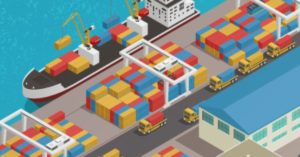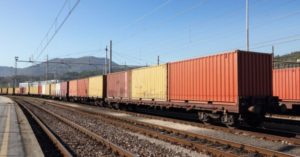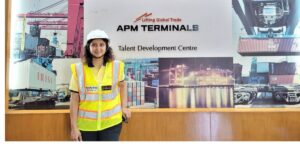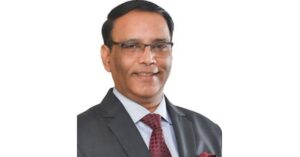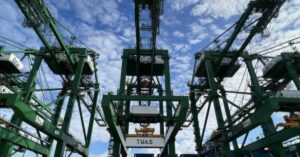In your profile, you mentioned that you help in achieving compliance, collaboration, and well-being. Well-being is such a nice word for business, especially it is very important not only for humans. So, tell me what is this Volteo Maritime and what do you do exactly?
If you notice the current scenario, especially the pandemic, the word “well-being” for us takes a significant importance because of all the pain and the suffering that the seafarers are going through. Some seafarers have been stuck at the oceans for more than a year, and no human can imagine themselves being blocked in a metallic metal box environment for beyond 12 months. So, when we started this, while we did not anticipate in November 2019 that the pandemic would strike, as we progressed along our product journey, we realized that the well-being notion of how seafarers’ mindset, how seafarers opinion should be taken on and if you would have to do it in a very non-intrusive fashion, then you will have to have those systems in place which allow them to sort of anonymously at least express their opinion to their management, to their colleagues and to the system that this is what is going through the industry, right. So, that came about after the fact for us, after the pandemic struck but when we started the project, when we started this entire engagement, our primary focus was to solve two major issue, the first issue is, over the last decade, if you see, a lot of literature, there is a lot of opinion about how regulatory and administrative practices actually add a significant overhead to a person whether he is in the shipping industry, the port sector, operating an LNG terminal, because these are highly regulated industries and when there is regulation and a lot of ecosystem partners that are looking for the same sort of information, the expectation is that the ground-level worker, whether it is the seafarer or the port worker, they constantly have to report back and demonstrate that they have been doing things in accordance to those regulations. Unfortunately, today, the only means that they have to demonstrate this regulation is pen and paper. At best, it could translate to a spreadsheet that could be emailed or a WhatsApp message that gets exchanged and we know, given the number of enterprises that we’ve personally worked with over the number of years, that anytime when you have systems which are primarily reliant upon pen and paper, spreadsheets, those create other problems that you don’t foresee, which is lack of visibility, lack of managing your asset properly. So, that is our first problem, is how do we tackle the element of compliance, how do we use currently the digital technologies in place to enhance those compliance, give them the decision support but do so primarily to reduce the burden of this regulatory aspect of it. That’s number one. The second, if you can think of it, while I have only been exposed to this industry for the last 5 to 6 years, one of my first opportunities to actually sail on a ship was something very enlightening for me. One of the largest ships right now is as long as 400 meters. Now this 400 meters floating industrial plant if you can think so, that is managed by a faint crew of anywhere between 20 to 22 young people. Now, 20 to 22 people if they have to maintain this asset of $40 to $50 million asset in the tip-top fashion that we expect them to, collaboration plays a very significant role and most of the software today is not designed to be collaborative, it also siloed, it’s there in a PC, captain has to operate, chief engineer has to operate and they have to talk through their phones and we believe this is all because softwares have been designed as if they designed it for land and it was designed for a completely different purpose. So, when we looked at that opportunity, we took a step back and we said, these are our two fundamental principles, is how do I enhance compliance by reducing the regulatory burden and while doing so, can we really enhance the ability for these people to collaborate using digital technologies? And that’s what our vision was.
So, as I understand, while the whole world is moving towards digitalization with great speed, I think the nautical speed of the shipping industry is still very slow. But tell me, is this the compliance on the paperwork now to be digitalized, is it any mandate from organizations like IMO or is it a business decision that the ship owners have to take?
I think it’s a combination of both. Fortunately, the regulation actually has been coming quite forward to push this agenda. We have noticed some forward-looking countries like Singapore for example since 2017 especially in terms of maintaining log books. So, today just for the context, there are anywhere between 20 to 25 different log books that one has to maintain and these log books have to be entered, in some cases, as frequently as every hour. Now, these 25 log books exist today on books and 90% of the industry is still continuing that practice. In 2017, Singapore came up with a regulation where they recommended most ship owners to say, it’s time to move to digital so that you can enhance the value and get the data and see digital insights coming out of it. So that’s one side. The second is October 1st 2020 MARPOL, which is Maritime Pollution Authority, they had come up with a recommendation, also accepting the fact that their log books, which are about 7 to 10 log books, can also be going to be electronic. So, there is certainly a tail wind right now coming into 2021, from the regulatory authorities themselves realizing that paper cannot be sustainable. It has to move to electronic. On the other side, you also have now ship owners, who in the past have previously dealt with the business model of buying the asset at a low price and then selling the asset a high price and that model right now is getting changed where they believe as they are asset owners, they need to still be able to provide good means to their employees, talent is becoming thinner in this industry, lot of previously available talent, especially at the higher scale, your chief engineers, your captains and your chief officers, they are not coming in as the same pace as they used to. So, if you will have to keep that talent, you would have to have innovation happen because you just can’t treat them as clerical workers and keep reporting a lot of paperwork. So, most managers and most operators now also realize that this is a worthwhile investment to make, to streamline their vessel operations. Last but not the least, there is lot of emphasis about optimization in generation. An asset can only yield that much value if you digitize it, and asset optimization typically leads into a greater innovation sense of adding IoT, your artificial intelligence, ML and things like that. Now with those investments coming into place, it requires a holistic approach, not just siloed approach. So, those 3 factors put together is definitely adding a lot of impetus to the industry to change.
That’s a very positive environment that we see today. So, from the problem statement to delivering the product or solution, whatever you call, where are you in the development cycle?
We started this exercise in November 2019. First 6 to 8 months for us has been a very immersive experience. One of the most fortunate things I think for us personally has been that we were part of a programme which gave access to the end users, which are our seafarers who are working on our vessels but not only that the subject matter experts who are sitting in our office along with their management executives who ultimately had the responsibility of seeing value derived out of this programme. So, our first 8 months have been, lot of immersive learning for us in trying to understand what is that we need to build, truly empathize with the end user so that we can build something across the entire ecosystem. So, since about September we have actually been piloting now. We are now piloting on 7 container vessels in EPS and then we also have a strong focus of rolling it out to couple of large Singapore tanker firms. In addition to that, we are talking to a firm in Saudi Arabia as well. So, the journey right now is focused in basically trying these out, trying the compliance, collaboration, piloting it over the next 3 months and then commercializing it from Q2 onwards.
So, what are the learnings so far and what is the response from the user?
Quite exciting sir. This journey for us when we ultimately as an engineer especially who’s been part of building products, one of the personal joys that I get is to see the product being actually in use and then somebody coming back to us and saying this is a very positive experience for us, right. So, that’s been what we were hoping for. I tell you a very simple example, there’s something called as a checklist that one has to fill in. A checklist today is done on paper and in the course of a voyage which can be typically anywhere let’s say, from Port A to Port B, at most, it might be 14 days but some of the frequent runs if you go between Singapore and Malaysia can be as frequently as 12 hours. Every time when you hit a port in this industry, you will have to file anywhere between 10 to 12 checklists and today all of them happen on paper. Now, when we talk to seafarers, they express saying, look I don’t have any problems in doing the checklists itself but it’s the process of printing the checklists first and then having to file it later and keep a track of where those files are is what frustrates us. So, for us, technologies can come into place essentially to eliminate that friction right. Because the first part of it is friction, the later part of it is friction and the in-between part of filling the checklists is what his expertise says and that’s the kind of things we are looking at, is what will you do to eliminate that friction and when we show our product, those are kind of things that we get back is thank you so much for thinking about us first and having to develop a product like this. The second example, I have been very fascinated by this is apparently, if you go towards port of East Coast of US or West Coast of US, there are certain times in the year, where whales migrate and when whales are migrating, there is a recommendation that your ship cannot operate beyond 10 nautical miles per hour. Now, imagine yourself as a captain and you are going towards that coast, how do you know which areas whales would be in. It’s humanly very difficult for you to think about it as you still have to operate in those conditions and you don’t know when to hit it. You do not want to be really driving without understanding where these are. So, those are the places when we can bring technology to aid them. So, the way we describe our software is we will tell you what to do in certain areas and we will also tell you what not to do in a certain and that’s what we are trying to bring about the change.
Okay. This software is Wayship right?
That’s correct.
Apart from bringing down the cumbersome process of the people working on the ships in terms of filing these reports, what is the advantage for the ship owner in terms of either time and cost efficiency?
The time factor is certainly there. So, if you can think of it today, the estimates are indicating that regulatory paperwork in certain cases can take as much as one-third of a work week of an individual. So, the highest paid individuals – your captain, chief engineer, chief officer, these people spend anywhere between 33% to 40% of their work week, essentially on documentation. So, we would like to bring our personal KPIs to reduce that by about 50%. So, essentially what we are doing is we are giving back time to these people where they can then focus that time upon higher order things like safety, safe navigation, proactive maintenance of the assets or the asset itself sans later right. So, that is the direct impact that we can see is one, easing the pressure, giving the time back so that they can focus upon more things of importance rather than just paperwork. The second aspect of it that we do is, as humans, we are all prone to errors and certain times, these errors can creep into in fashions where it reflects in a very very significant way to a ship owner. For example, a MARPOL log indicates that you have to at least fill in this information once a week. If you don’t keep up with that practice and you visit a port by failing to do that practice, there is a significant risk for a ship owner to be under the circumstances where if a port state inspector comes and looks at your book and you have not maintained it, especially in the US side of things, the default assumption is that you have not being following the regulations of MARPOL and in certain cases, there was a recent incident in Singapore where that led to a fine of about $11 million for a shipping firm. That’s a significant impact. Even worse impact is the brand value; if you are then reflected upon that you are not following practices and you are perhaps caught in a MARPOL violation, then it reflects poorly to your customers and it can have a significant violation as well. So, what we believe is there are sometimes inadvertent errors that we do as humans and if technology can prevent from making those errors, we certainly would like to do so.
Okay. Let us talk about the technology and platforms and the data part of it. So, how actually does it work on a ship? Do they carry devices and is your software compatible with lot of things that are available because it is connected world ultimately, and then how the data gets stored and retrieved and used? Can you explain that a bit?
Yeah and truly that’s our genesis actually. So, if you can think of it, our lives, for the last 10 years, if you put the three things together, the ability to use infrastructure on the cloud, the ability to leverage the power of a mobile phone and combine with real time data that’s coming in through either crowdsourcing or your sensors and things like that, that is what has given us the experience that we deserve, right. Your Ubers, your Amazons of the world is what. Now, when we got into the program, that’s the first question we asked ourselves. If you had abundant availability of these three technologies on a ship, how would that transform the way work gets done on ships, so we took that same exercise and we now are coming up with a solution where seafarers are mobile, they don’t sit at one place and work on a desk, they have to constantly keep moving around and if they have to move around, then we will have to have ability to take the work to where the work is getting done. For example, if somebody is doing a repair on a deck work and if he has to report back to his boss saying I have done the work, here is a picture for it, our idea is that we will provide them tablets where they can do the work of a checklist and then go the place where the work is getting done and take a picture. Today, that happens through a point and shoot camera, they bring SD card and all that. That’s friction for us. So, the way the ecosystem of solution that has been built for us is that first thing is we will provide them mobile devices, these are tablets that are available on the vessels. If there are infrastructure like laptops and PCs that are already been available either for captains and chief engineers, we will also install a software on that and these network of devices that now are available on the ship become the collaborative link and for this to happen, it’s all happening offline. It does not need to have internet because if you are in the middle of the ocean, we can’t expect always the internet to function but if the internet is available, in real time, we transfer the data back to the shore and now your people sitting in the headquarters will have a real time visibility of all the things that are happening at the vessel level and then we can also add more higher order things of learning how this data can be harnessed in terms of insights.
What is the size of opportunity that you see Surendra?
Significant. There are about 70,000 vessels that are operating our oceans. There are about 2 million seafarers that are operating our oceans again and in terms of how software is just percolating this industry, it’s in a very nascent stage I would say. I mean, while there are lot of softwares that are available, there are few softwares that have been built in the last few years leveraging these technologies. I think there is a lot of interest, there is a lot of spike in the number of startups that are participating in this ecosystem. So, in terms of the size of the market, we would estimate it right now to be about $4 billion and it’s likely to expand to $8 billion by 2025, 2027, so very significant.
That’s a huge pie. Are you alone to have the cake or you have competition in this space?
There is certainly competition. There is a lot of activity that is happening in this space, from how, as I said since the regulation itself is moving, there is a lot of awareness now within the ecosystem that there is an opportunity that’s available, certainly a lot of ship owner interest drives transformation within their enterprises. So, there is certainly a lot of enterprises that are vying for this pie. I think the idea is that rather than be mentally focused upon competition, we believe our experience speaks for itself is that we came from enterprise transformation. Our focus is looking at digital transformation for enterprises which traditionally have been behind and holistically building a solution like this requires slow and steady pace and we have enough market share to go after.
So, what is your immediate action plan from the pilot. How quickly you want to roll out this and then capitalize on what you have built?
That’s the competitive difference that we bring to the table as well is when we build software, if you can imagine, if you build the software for land-based, you have access to that customer in a very simple way, you could just take a flight or a transportation just to go to his office to get it fixed, but if you are deploying software for a ship and if she is in the middle of the ocean, then it will become very difficult for us to support. So, that’s the notion that we build the software is to be highly scalable; deployment is a challenge in this industry in general. So, we are building software that go from 0 to 150 ships in a very short amount of time. So, our idea is that we will stabilize that over the next 3 months and then after that the goal is pretty much to scale very fast after that. We are looking to at least partner with 4 to 5 key marquee customers to understand and bring in the best practices of what needs to be done and 2022 is where the expansion will happen.
Apart from Wayship, what else you do with your maritime?
So, the entire journey for Wayship actually started with our exposure to ports. So, we are fortunate enough in 2016 to get an opportunity to drive a digital transformation experience here in one of the ports in Andhra Pradesh, it’s called Kakinada Anchorage Port. It’s a government port, it’s also an anchorage port, primarily focused on bulk cargo; they don’t do containers, and the idea with them was when we entered, then we were fortunate to witness that they didn’t have anything and now they have a system in which during Covid, none of them had to come to offices to operate the port. Fabulously, were able to bring in as many vessels as they needed, completely go through this process through a paperless transformation, including payments. We have got a full-fledged payment gateway that has been integrated, where all the freight forwarders are part of that eco system and they just go through the payment cycle without having to experience the friction that we talked about in this sector as well. So, that journey for us is what opened up interest in the larger segment. So, we look at our marketspace as there for us to provide value to bulk cargo ports on one side, shipping industry to the second, primarily focused upon ships transformation, vessel operation, and then on the other side, we are looking to expand to liquid terminals.



